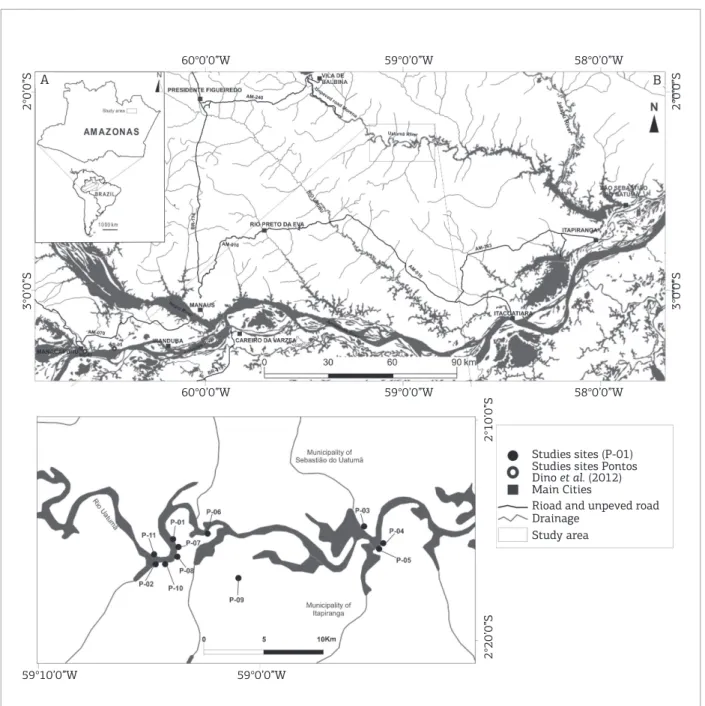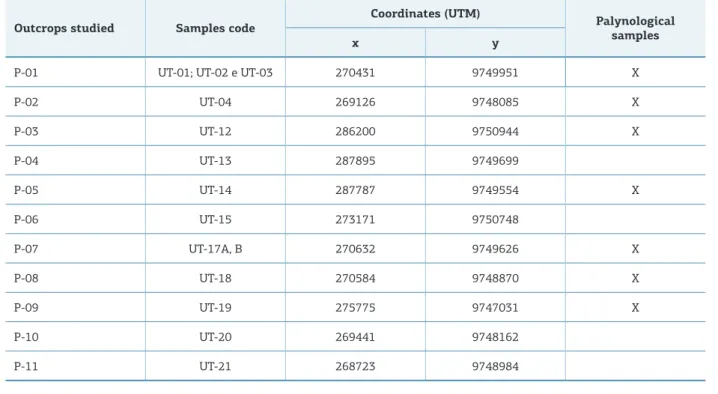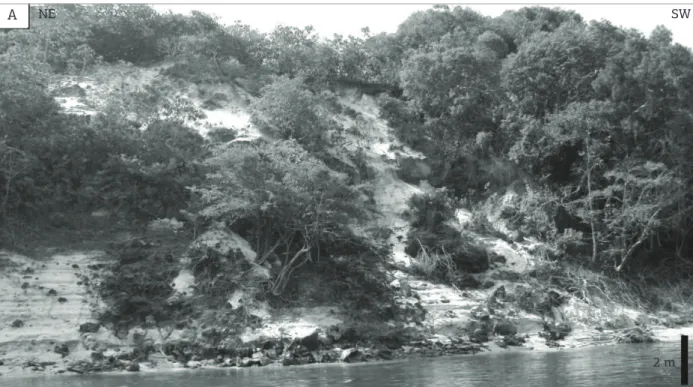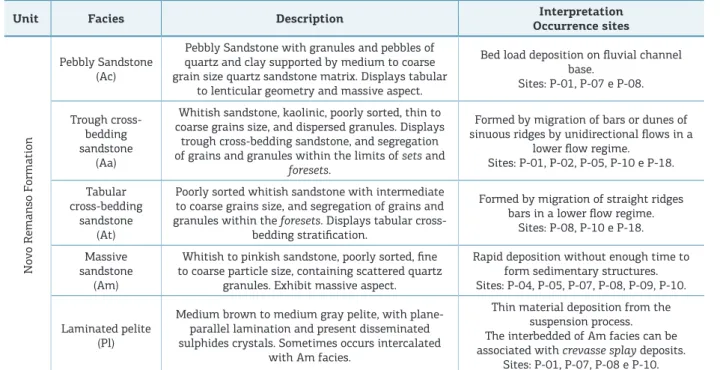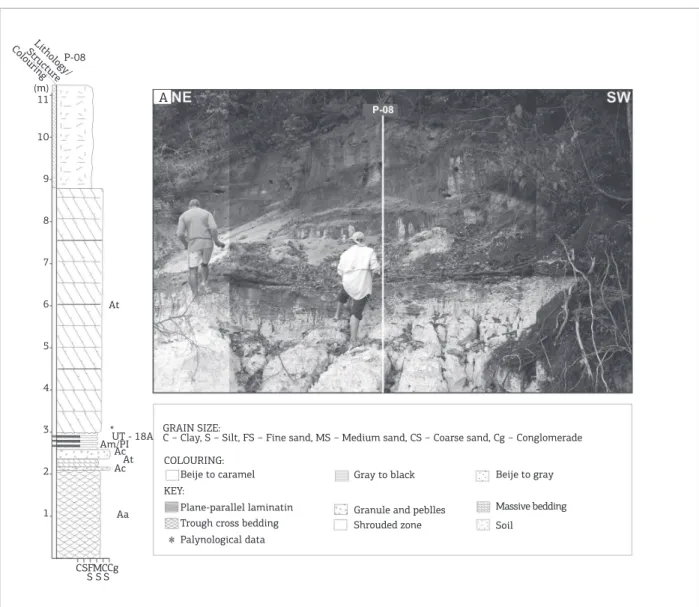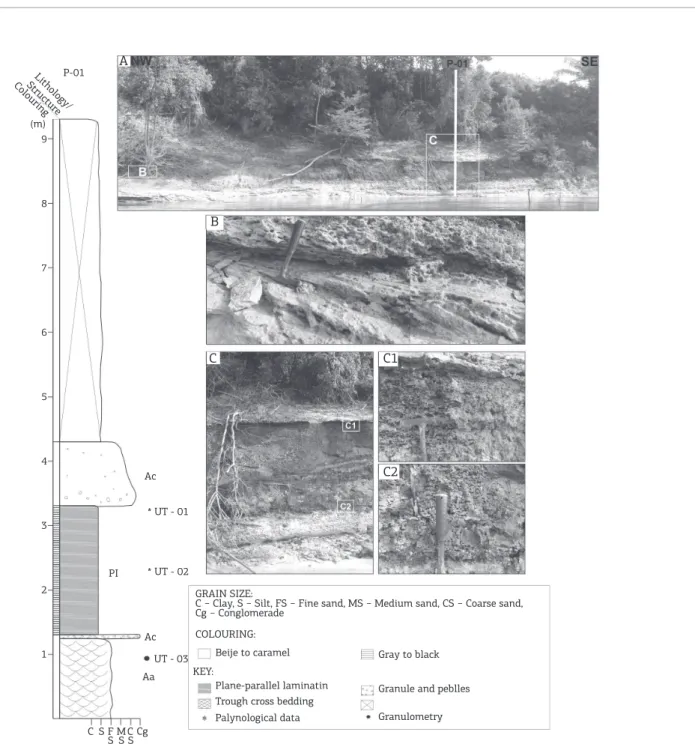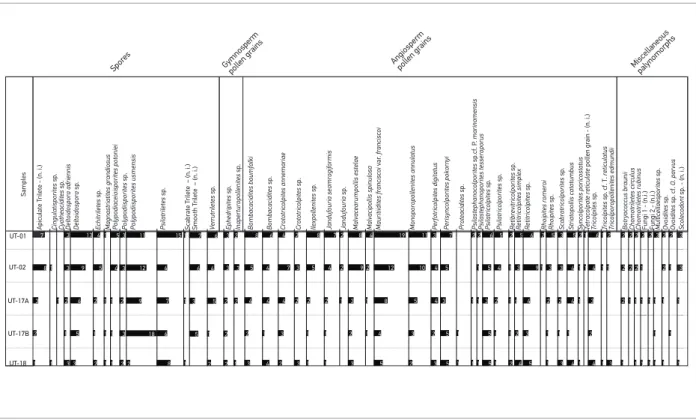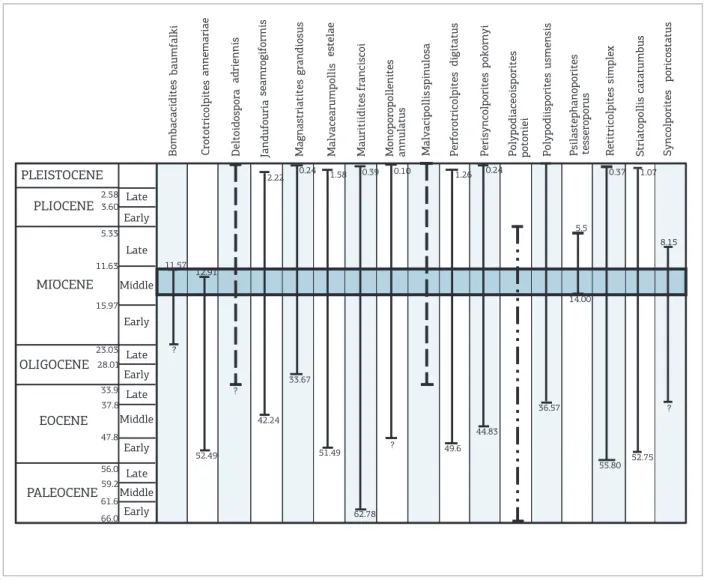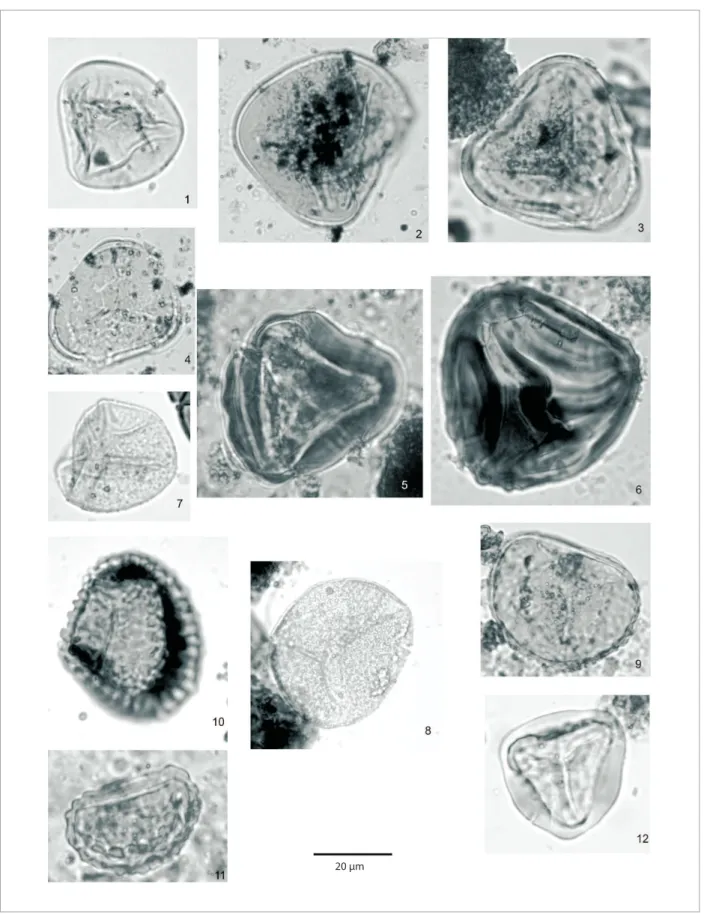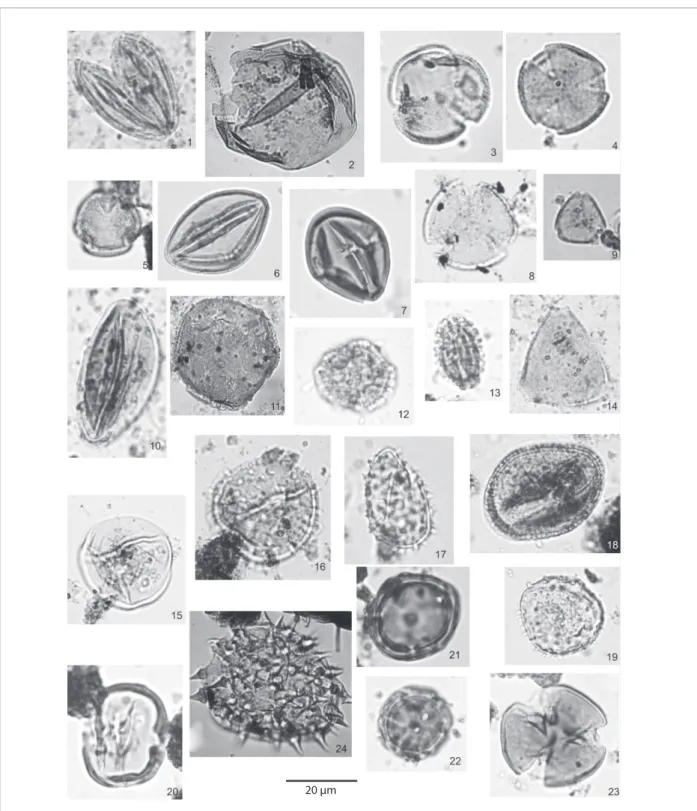1Institute of Exact Sciences, Department of Geosciences, Universidade Federal do Amazonas – UFAM, Manaus (AM), Brasil. E-mail: easoares@ufam.edu.br 2Petrobras/CENPES/PDEDS/AMA, Rio de Janeiro (RJ), Brasil. E-mail: dino@petrobras.com.br
3Department of Stratigraphy and Paleontology, Universidade do Estado do Rio de Janeiro – UERJ, Rio de Janeiro (RJ), Brasil. E-mail: luziaa@uerj.br 4Secretaria Municipal de Cultura do Município de Presidente Figueiredo – SEMUC, Amazonas (AM), Brasil. E-mail: cavernamarco@gmail.com
*Corresponding author.
Manuscript ID: 30283. Received in: 04/16/2015. Approved in: 08/21/2015. ABSTRACT:he scarcity of stratigraphic data has hindered the de-marcation of the outcropping area of Miocene deposits of the Ama-zon Basin, represented informally by the Novo Remanso Formation. Moreover, this unit is characterized by a sparse and irregular geogra-phic distribution due to its sedimentological features and rare fossil content. Miocene deposits cropping out in central Amazonas Basin area were described in sedimentological terms and analyzed palyno-logically. All analyses were undertaken in samples collected at the Uatumã River banks (Itapiranga and São Sebastião do Uatumã cities). Lithostratigraphic data shows that Novo Remanso Formation consists of sandstones, with subordinate conglomerates and pelites, characte-ristic of a meandering luvial paleosystem, with luvial channel, point bar, loodplain and crevasse splay facies. he palynolora retrieved from ive samples consists exclusively of continental-origin palynomorphs dominated by angiosperms species. Trilete spores are well represented, while gymnosperms pollen grains are minor components. he presen-ce of Psilastephanoporites tesseroporus, Syncolporites poricostatus, Jandu-fouria seamrogiformis and Polypodiaceoisporites potoniei ensure these de-posits its into the Grimsdalea magnaclavata palynozone (Regali et al. 1974a, b), and the Grimsdalea magnaclavata/Crassoretitriletes vanra-adshooveni palynozones of Jaramillo et al. (2011) considered Middle Miocene age. his age is conirmed by the zonation of Jaramillo et al. (2011), based on the LADs of Bombacacidites baumfalki (11.57Ma) and Crototricolpitesannemariae (12.91Ma); and the FAD of Psilaste-phanoporites tesseroporus (14.00Ma). With these new data presented herein, it is possible to assume that the Miocene strata represented by the Novo Remanso Formation covers a larger area in the basin than previously considered, and that it may be extended for about 300 km until the Manacapuru village, indicating a Miocene subsidence phase.
KEYWORDS: Novo Remanso Formation; Miocene; Amazonas Basin; Northern Brazil Basins.
RESUMO:A escassez de dados estratigráicos tem diicultado a delim-itação da área alorante dos depósitos miocenos da Bacia do Amazonas, representados informalmente pela Formação Novo Remanso. Ademais, essa unidade caracteriza-se por uma distribuição geográica esparsa e ir-regular, dada suas características sedimentológicas e raro conteúdo fóssil. Estudos litoestratigráicos e palinológicos ora realizados em aloramentos do Rio Uatumã permitiram identiicar a ocorrência dessa formação no limite dos municípios de Itapiranga e São Sebastião do Uatumã. Da-dos litoestratigráicos revelam que a Formação Novo Remanso consiste dominantemente de arenitos, com conglomerados e pelitos subordinados, característicos de um paleosistema luvial meandrante, com fácies de ca-nal, barra em pontal, planície de inundação e crevasse play. A palinolora recuperada de cinco amostras é composta exclusivamente por palinomor-fos de origem continental. O predomínio é de espécies ains às angio-spermas. Esporos triletes estão bem representados, enquanto os grãos de pólen gimnospérmicos são componentes menores na associação. A presença das espécies Psilastephanoporites tesseroporus, Syncolporites poricostatus, Jandufouria seamrogiformis e Polypodiaceoisporites potoniei assegura que esses depósitos se enquadram na palinozona Grimsdalea magnaclavata (Regali et al. 1974a, 1974b) e nas palinozonas Grimsdalea magna-clavata /Crassoretitriletes vanraadshooveni de Jaramillo et al. (2011), de idade Mioceno Médio. Dados de Jaramillo et al. (2011) conirmam essa idade, com base nas LADs das espécies Bombacacidites baumfalki (11.57 Ma) e Crototricolpites annemariae (12.91 Ma); e FAD de Psi-lastephanoporites tesseroporus (14.00 Ma). Esses novos dados ampliam as informações exaradas por Dino et al. (2012) sobre a Formação Novo Remanso e ratiicam que as camadas miocenas cobrem uma área bem maior que a previamente considerada, podendo estender-se por cerca de 300 km até o município de Manacapuru.
PALAVRAS-CHAVE: Formação Novo Remanso; Amazonas; Bacias
do Norte do Brasil.
New sedimentological and palynological
data from surface Miocene strata in the
central Amazonas Basin area
Novos dados sedimentológicos e palinológicos de camadas
miocenas alorantes na área central da Bacia do Amazonas
Emílio Alberto Amaral Soares1*, Rodolfo Dino2,3, Dominicky Peres Soares1,
Luzia Antonioli3, Marco Antônio Lima da Silva4
INTRODUCTION
he current stratigraphic framework of the Amazonas Basin, proposed by Cunha et al. (2007), comprises two irst order megasequences, one Paleozoic and the other Mesozoic-Cenozoic. While the Paleozoic sequence has been object of numerous studies, due to its interest by the oil industry, the Mesozoic-Cenozoic (Javari Group) still lacks detailed litho-stratigraphic/geochronological data aiming at the individual-ization of its constituent units. his sequence is represented mainly by the Cretaceous unit (Alter do Chão Formation), which extends uniformly throughout the basin and exhibits maximum thickness of 1,250 m. he Cenozoic sedimen-tary record, with a maximum thickness of 200 m (Cunha et al. 2007), has been assigned to the strata of the Solimões and Marajó formations, occurring restrictedly nearby Purus and Gurupá arches, respectively. However, these formations belong to the stratigraphic framework of the Solimões and Marajó basins, and their occurrence in the Amazon Basin has been questioned.
Only since 2000, stratigraphic, sedimentological and sedimentary facies studies (Rozo 2004, Soares 2007, Soares et al. 2010) allowed the individualization of post-Cretaceous sediments in outcrops along the Solimões-Amazonas river system in the area between Manacapuru and Itacoatiara, central portion of the Amazon Basin. hese deposits occur unconformably on top of the Alter do Chão Formation, being marked at the base and at the top by lateritic paleosols, and they have been informally termed Novo Remanso Formation, according to the homonymous locality east of Manaus. he age of this unit was determined by Dino et al. (2012) based on two sites studied in the city of Manacapuru, and this age can be positioned unambiguously in the Middle Miocene. As this is a new lithostratigraphic unit of the Amazon Basin, with restricted occurrence in the central portion of the basin, regional distribution of this formation has not yet been well deined in regional geological maps (CPRM 2006, 2008). However, additional geological and subsurface geophysical data (boreholes) conirmed the continued presence of this sedimentary cover for ca. 180 km between Manaus and Itacoatiara (Costa 2002, Andrade & Soares 2009).
his study describes for the irst time, based on sedimen-tary facies, stratigraphic and palynological data, the occur-rence of luvial Miocene deposits in the middle and lower sections of Uatumã River (Itapiranga and São Sebastião do Uatumã municipalities boundaries) (Fig. 1). he deposits are mainly sandstones with conglomerates and subordi-nate pelites, and to the north are in direct contact with the Paleozoic rocks of the northern edge of the Amazon Basin. Identifying Miocene deposits in this section of the Uatumã River enables us to enlarge the area of occurrence of this
unit for about 300 km until Manacapuru, emphasizing a subsidence phase of the Amazon Basin during this period.
he determination of the age of this unit was based on spore-pollen recovered material composed exclusively of con-tinental palynomorphs in which the presence of the species Psilastephanoporites tesseroporus, Bombacacidites baumfalki and Crototricolpites annemariae allowed us to constraint these deposits, according to Jaramillo et al. (2011) at Middle Miocene age (14.00 to 11.57 Ma).
STUDY AREA
his study focused on 11 outcrops continuously exposed in the middle and lower sections of the Uatumã River, which border the municipalities of Itapiranga and São Sebastião do Uatumã (Fig. 1, Tab. 1). he deposits are of Miocene age, and we performed stratigraphic, sedimentary and pal-ynological analyses. he access to the area was through BR-174 and AM-240 roads and a secondary road (Ramal da Morena), but mainly through the river Uatumã, which allowed better access to the studied outcrops in the months of October and November (2011 and 2012, during the low water level season of the rivers.
MATERIALS AND METHODS
he characterization of Miocene deposits in outcrops on the banks of the Uatumã River (Fig. 2) covered stratigraphic, sedimentary facies and palynological analysis. he facies analysis was based on determination of the geometry, par-ticle size, texture, sedimentary structures and paleocurrent patterns following the concepts of Walker (1992, 2006). he geological mapping of the unit through a section of about 25 km along the river relied primarily on develop-ing columnar proiles and panoramic sections. hese were prepared from photomosaics following Wisevich (1991).
conventional laboratory procedures (e.g. Phipps & Playford 1984; Wood et al. 1996); the technique, briely, involves the following steps:
1. physical degradation of about 60 g of pre-sterilized sam-ples into small pieces (1–3 mm diameter),
2. removal of carbonates by the addition of diluted hydro-chloric acid (20%), all the samples had very low con-tent of carbonates,
3. dissolution of the silicates by immersion in concentrated hydroluoric acid (70%),
4. removal of remaining luorsilicates using hot hydro-chloric acid 50%,
5. careful and controlled oxidation with concentrated nitric acid for 5–10 minutes,
6. concentration of palynomorphs via heavy liquid (ZnCl2
solution - density 2.0). After each step, the residue was
neu-tralized with distilled H2O, proceeding to the next stage.
he inal residue was mounted on individual slides, and three slides were prepared per sample.
Studies sites (P-01)
Study area 58°0’0”W 59°0’0”W
59°0’0”W 59°10’0”W
2°20’0”S
2°10’0”S
60°0’0”W
A B
58°0’0”W
2°0’0”S
3°0’0”S
2°0’0”S
3°0’0”S
59°0’0”W 60°0’0”W
Drainage
Rioad and unpeved road Main Cities
Studies sites Pontos Dino et al. (2012)
he slides were scrutinized in detail and the representa-tive palynomorphs of age and environment were captured by a Zeiss MC 80 DX camera attached to a Zeiss Axioplan microscope from the Department of Stratigraphy and Paleontology, Faculty of Geology, Universidade do Estado do Rio de Janeiro (UERJ), where the slides are cataloged and stored under the notations UT-01, UT-02, UT-03, UT-04, UT-12, UT-14, UT-17, UT-18 and UT-19.
GEOLOGICAL AND
PALEONTOLOGICAL CONTEXT
OF PALEOGENE-NEOGENE
SEDIMENTARY UNITS OF THE
AMAZONAS BASIN
Stratigraphic and nomenclatural aspects
By the end of the last century, Cenozoic units did not use to be individualized in the geological maps of the Amazonas Basin, and the entire post-Paleozoic sedimentary cover was generally assigned to the Alter do Chão Formation (Cretaceous). his was also the case of the sedimentary ill of tectonic depressions (grabens) developed over the Paleozoic basement on the northern edge of the basin in the region of Presidente Figueiredo (Nogueira et al. 1997).
Deining post-Cretaceous sedimentary units (Neogene and/or Paleogene) in the Amazonas Basin has been diicult
due to the lack of systematic geological and paleontological studies, due mainly to the sandy and oxidized character of the deposits, which result in poor fossil potential. Pioneering studies by Mendes (1957) and Price (1960) “hypothetically” limited units of Pliocene (?) overlaid on the Cretaceous unit in boreholes in the regions of Alter do Chão (Pará) and Nova Olinda (Amazonas), with thicknesses around 500 and 170 m, respectively, related to the “Série Barreiras”. Palynological data obtained from surveys of the basins of northern Brazil (Acre, Solimões, Amazonas and Marajó) allowed the individ-ualization of tertiary units within the XVIII range deined by Daemon and Contreiras (1971). hese units were included in the Cretaceous-Tertiary sequence deined for the Alter do Chão Formation (Travassos & Barbosa Filho 1990, Cunha et al. 1994). he current stratigraphic chart of the basin
(Cunha et al. 2007) individualizes Cenozoic deposits related
to the Solimões and Marajó formations, occurring restrict-edly nearby the Purus and Gurupá arches, respectively. In the western portion of the basin, Caputo (1984) deined tertiary deposits assigned to the Almerim Formation on the 2-AL-1-AM hole (Petrobras).
Geological and geophysical studies of boreholes (Costa 2002, Andrade & Soares 2009) deined an extensive Neogene sedimentary cover that extends for about 260 km between Manaus and Itacoatiara (central portion of the Amazon Basin) and presents a thickness of about 80 m. In this region, out-crops of probable Miocene age were also described on the
Table 1. Analyzed outcrops coordinates.
Outcrops studied Samples code
Coordinates (UTM)
Palynological samples
x y
P-01 UT-01; UT-02 e UT-03 270431 9749951 X
P-02 UT-04 269126 9748085 X
P-03 UT-12 286200 9750944 X
P-04 UT-13 287895 9749699
P-05 UT-14 287787 9749554 X
P-06 UT-15 273171 9750748
P-07 UT-17A, B 270632 9749626 X
P-08 UT-18 270584 9748870 X
P-09 UT-19 275775 9747031 X
P-10 UT-20 269441 9748162
banks of the Solimões-Amazonas luvial system (Rozo 2004, Soares et al. 2010, Gonçalves Júnior 2013), limited on the base and on the top by lateritic paleosols and overlying the Cretaceous unit. However, these studies did not pres-ent any dating, and the Miocene chronostratigraphic posi-tion was based solely on the correlaposi-tion of lateritic paleosols limiting those deposits, as deined in eastern Amazonia by Kotschoubey and Truckenbrodt (1981), Costa (1991), Rossetti (2001) and Rossetti et al. (2013). In the region of Itacoatiara, this unit has about 10 m of outcrop thickness, consisting of coarse to ine ferruginous sandstones, with cross-tabular stratiication and interbedded mudstones, representing channel and loodplain deposits related to a meandering luvial paleosystem (Rozo, 2004). he informal designation of Novo Remanso Formation was assigned by Rozo et al. (2005) due to its occurrence in the homonymous locality southwest of Itacoatiara.
Soares (2007), studying Novo Remanso Formation out-crops in Manacapuru, proposed a subdivision in the upper and lower units according to three levels of lateritic paleossols described at the base, the intermediate portion and the top. his subdivision was adopted by Dino et al. (2012), who dated the upper section positioning it unequivocally in the Middle Miocene, while the lower section can be extended to the Lower Miocene. According to these studies, the for-mation consists mainly of sandstones, with pelites and con-glomerates, representing channel deposits, point bars and loodplain of a meandering luvial paleosystem.
he lithostratigraphic formalization of Novo Remanso Formation has not been well established. However, the nomenclature has been adopted in regional geological studies of Central Amazonia. In the CPRM map (2008), large areas attributed to Miocene sedimentary cover stretch between Manaus, Nova Olinda do Norte, Boa Vista de Ramos and Urucará, and were demarcated (acronym N12 nr) totaling dozens of kilometers.
In recent studies, Caputo (2009, 2011) proposed changes in the post-Paleozoic lithostratigraphic nomenclature of the Amazonas Basin. Based on existing paleobotanical, palynolog-ical and geophyspalynolog-ical studies of the basin, the author accepted an extensive Tertiary sedimentary cover along its entire length, calling it “Alter do Chão Formation”, overlying the Cretaceous unit that was called “Jazigo da Fazendinha Formation”.
LITHOFACIES
General aspects
In general, the proiles studied in Rio Uatumã exhibit altered outcrop thickness of 10 to 15 m, it is not possible to observe the lower limit with the underlying Paleozoic units.
Sometimes, they display whitish sandy soils (Spodosols), quartz and friable, with organic material disseminated and variable thickness (Fig. 2). Spodosols have been described in several places between Manaus and Presidente Figueiredo, being formed on the deposits of the Alter do Chão Formation (Horbe et al. 2003, 2004).
he studied proiles contain mainly sandstones with conglomerates and subordinate pelites arranged in layers that extend for dozens of meters. Five distinct sedimentary facies were identiied (conglomeratic sandstone – Ac, sand-stone with trough cross-bedding – Aa, tabular cross-bedding sandstone – At, massive sandstone – Am, and laminated pelite – Pl), which are discussed according to the classiica-tion of Miall (1985, 1996) (Figs. 3 to 5, Tab. 2).
Pebbly Sandstone – Ac
Description – his facies is formed of conglomerate of whitish to yellowish coloring with massive aspect. It displays granules and pebbles of quartz and clay, poorly selected, measuring between 2 – 8 cm, ranging from sub-angular to rounded, slightly spherical and without preferential orien-tation, supported by a medium to coarse grain size quartz sandstone matrix, moderately selected. he layers present 5 – 60 cm thickness and are sometimes coarsening upward, being overlapped and underlapped by the Am, Aa, At and Pl facies through sharp contacts (Figs. 3 to 5, Tab. 2 ).
Sandstone With Trough Cross-Bedding – Aa Description – his facies is composed of whitish sand-stone, a little clayey (kaolinic), with poorly sorted grains, which vary from sub-angular and sub-rounded, thin to coarse, with granules (quartz, feldspar and clay) from 1 to 3 cm in diameter, dispersed in layers. It also displays medium to large sandstone with trough cross-bedding, segregation of grains and granules within the limits of sets and foresets. his facies usually occurs in compound sets of tabular layers with thickness ranging from 1 to 2 meters. he Aa facies occurs underlapping the Ac facies, not being possible to observe the lower limit (Figs. 3 to 5, Tab. 2).
Tabular Cross-Bedding Sandstone – At
Massive Sandstone – Am
Description – his facies is composed of whitish to pinkish sandstone, poorly sorted, ine to coarse particle size, containing scattered quartz granules (Figs. 3 and 4, Tab. 1). It features a massive aspect and sometimes displays silici-ied portions with individual layers ranging from 3 cm to about 3 m. his facies exhibit mildly undulating contact with underlapped Pl facies and straight contacts with At and Ac underlapped and overlapped facies.
Laminated Pelite – Pl
Description – his facies is deined by medium brown to medium gray colour pelite, with plane-parallel lamination. It usually occurs on individual tabular layers with a thick-ness of up to 2 m and sometimes intercalated to centimet-ric layers of thin massive sandstone (Am facies) (Figs. 3 to 5, Tab. 1). In the bedding planes, it displays disseminated sulides crystals.
COMPOSITION, AGE
AND ENVIRONMENTAL
CHARACTERISTICS OF THE
PALYNOFLORA
Despite currently being the best elements for dating and correlation of continental strata of Brazilian Cenozoic
basins, by allowing correspondence with the coeval marine strata of the continental margin basins, palyno-logical studies carried out on Tertiary sections (Paleogene-Neogene) of the Amazonas Basin are extremely rare and mainly restricted to studies by Daemon and Contreiras (1971) and Dino et al. (2006, 2012). Palynological stud-ies have been important in other regions of Amazonia and tropical South America including Van der Hammen (1957a, 1957b), Van der Hammen and Wijmstra (1964), Leidelmeyer (1966), Germeraad et al. (1968), Wijmstra (1971), Regali et al. (1974a, 1974b), Dueñas (1980), Lorente (1986), Müller et al. (1987), Hoorn (1993, 1994a, 1994b, 1994c), Leite et al. (1997), Jaramillo and Dilcher (2000, 2001), Pardo-Trujillo et al. (2003), Helenes and Cabrera (2003), Silva (2004, 2008), Leite (2007), Jaramillo et al. (2007, 2011) and Da Silva-Caminha et al. (2010).
his remarkable diference in terms of number of pub-lications most likely occurs due to the scarcity of produc-tive horizons, the diiculty in locating these levels and unfavorable conditions for the preservation of palyno-morphs given the dominant depositional paleoenviron-ments during the sedimentation of the Tertiary layers on the Amazonas basin. Combined with this, the current pedogenic processes in a hot and humid climate which alter and modify the exposed rock hinder the preservation of its fossils constituents.
SW NE
2 m
A
P-07 (m)
11 10
9
8
7
6
5
4
3
2 Aa
GRAIN SIZE:
C − Clay, S − Silt, FS − Fine sand, MS − Medium sand, CS − Coarse sand, Cg − Conglomerade
COLOURING:
Beije to caramel Gray to black
Soil Massive bedding Shrouded zone
Granule and peblles Palynological data
Trough cross bedding Plane-parallel laminatin KEY:
Ac Ac Am
UT - 17A,B PI *
1
S S S S C FMCCg
Lithology/ Structure Colouring
A
B
Figure 3. Outcrop panoramic and columnar sections (P-07 locality) on the Uatumã River right bank (detail A).
The detail B shows the laminated pelite layer with samples locations. Aa, Ac, Pl and Am correspond to the sedimentary facies.
Table 2. Characteristics of the Novo Remanso Formation main lithofacies.
Unit Facies Description Interpretation
Occurrence sites
No
v
o Remanso F
ormation
Pebbly Sandstone (Ac)
Pebbly Sandstone with granules and pebbles of quartz and clay supported by medium to coarse grain size quartz sandstone matrix. Displays tabular
to lenticular geometry and massive aspect.
Bed load deposition on luvial channel
base. Sites: P-01, P-07 e P-08.
Trough cross-bedding sandstone
(Aa)
Whitish sandstone, kaolinic, poorly sorted, thin to coarse grains size, and dispersed granules. Displays
trough cross-bedding sandstone, and segregation of grains and granules within the limits of sets and
foresets.
Formed by migration of bars or dunes of
sinuous ridges by unidirectional lows in a lower low regime.
Sites: P-01, P-02, P-05, P-10 e P-18.
Tabular cross-bedding
sandstone (At)
Poorly sorted whitish sandstone with intermediate to coarse grains size, and segregation of grains and granules within the foresets. Displays tabular
cross-bedding stratiication.
Formed by migration of straight ridges
bars in a lower low regime.
Sites: P-08, P-10 e P-18.
Massive sandstone
(Am)
Whitish to pinkish sandstone, poorly sorted, ine
to coarse particle size, containing scattered quartz granules. Exhibit massive aspect.
Rapid deposition without enough time to form sedimentary structures. Sites: P-04, P-05, P-07, P-08, P-09, P-10.
Laminated pelite (Pl)
Medium brown to medium gray pelite, with plane-parallel lamination and present disseminated sulphides crystals. Sometimes occurs intercalated
with Am facies.
Thin material deposition from the suspension process. The interbedded of Am facies can be associated with crevasse splay deposits.
Regardless of these adverse conditions, an extensive ieldwork is being carried out on the north margin of the Amazonas Basin, by the Research Group “Geologia Sedimentar da Amazônia – GSA” from Universidade Federal do Amazonas (UFAM), aiming to identify and map the possible presence of post-cretaceous deposits, specially Miocene, in the region, evaluating the hypoth-esis of a greater coverage of these strata in the area, which would indicate a subsidence phase of the basin on the Miocene. Ten (10) samples were collected containing some organic content for palynological analysis, and ive (5) resulted fertile (see Appendix I), which allowed the age and depositional environment deinition of their supporting layers.
he palynolora retrieved from carbonaceous pelitic levels of Novo Remanso Formation is moderately rich and
diverse, and it is in reasonable conditions of preservation. It is quite similar to that association identiied by Dino et al. (2012) for this same formation in two localities in Manacapuru, west of Manaus, and is composed of angio-sperms and gymnoangio-sperms related pollen grains, pterido-phytes spores, algae, fungi and scolecodonts. Seven hun-dred and eight palynomorphs were counted, comprising 43 genera and 58 species.
Figure 6 summarizes the palynological data and shows that the spore-pollen assemblages are dominated by pollen grains related to angiosperms (23 genera, 28 species and 406 forms counted), comprising 58% of the palynomorphs identiied, with and abundant presence of tricolpates and tricolporates forms; Retitricolpites,
Bombacacidites and Perisyncolporites are the most
com-mon genera. he second most represented group is the
P-08 (m)
11
10
9
8
7
6
5
4
3
2
Aa
GRAIN SIZE:
C − Clay, S − Silt, FS − Fine sand, MS − Medium sand, CS − Coarse sand, Cg − Conglomerade COLOURING:
Beije to caramel Gray to black Beije to gray
Soil
Massive bedding Shrouded zone
Granule and peblles Palynological data
Trough cross bedding Plane-parallel laminatin KEY:
Ac Ac At
At UT - 18A Am/PI
*
1
S S S S C FMCCg
Lithology/ Structure Colouring
A
Figure 4. Outcrop panoramic and columnar sections on the Uatumã River right bank (P-08 Locality) (detail A). Aa,
P-01
(m) 9
8
7
6
5
4
3
2
Aa
GRAIN SIZE:
C − Clay, S − Silt, FS − Fine sand, MS − Medium sand, CS − Coarse sand, Cg − Conglomerade
COLOURING:
Beije to caramel Gray to black
Granulometry Granule and peblles Palynological data
Trough cross bedding Plane-parallel laminatin KEY:
Ac
Ac UT - 01
PI *
UT - 02
UT - 03 *
1
S S S S C F M C Cg
Lithology/ Structure Colouring
A
B
C C1
C2
Figure 5. Outcrop panoramic and columnar sections of the Uatumã River let margin (P-01 locality) (detail A). The detail B displays sandstone layer with trough cross-bedding. The detail C shows the pelite layer with the
collected samples, stressing their upper limits (detail C1) and bottom (detail C2). Aa, Ac and Pl correspond to the sedimentary facies.
pteridophytes spores (12 genera, 18 species and 239 counted grains) that make up 33% of the association; Polypodiisporites, Deltoidospora and Psilatriletes are quite frequent. he other representatives are minor components of the palynolora, with percentages not exceeding 3%, while on the group of gymnosperms only 2 genera were identiied (Inaperturopollenties and Ephedripites); algae
(including here the genus Chomotriletes = Concentricystes) had 3 genera and 5 species. Among the fungi, only 1 genus was identiied and 11 forms counted.
organic residue of continental origin. Coastal or transitional environmental indicative forms such as pollen grains typ-ical of mangrove plants (e.g. Rhyzophora, Avicennia) were not identiied either.
he most important palynolora constituents indi-cate that the dominant paleovegetation at the Novo Remanso Formation deposition time was composed by Palm forests (Mauritiidites), lowland forests (Bombacacidites, Perisyncolporites) and aquatic components (Deltoidospora, Botryococcus, Chomotriletes) in hot and humid climatic conditions. Particularly important in the paleoenviron-mental deinition is the frequent presence of the following species: Bombacacidites spp., representing tropical forests developing trees (Fuchs 1964) and common along rivers and streams, being well adapted to poor, sandy and well drained soils (Hoorn 1994a); Jandufouria seamrogiformis, indicative of plants well adapted to inner alluvial plain environments (Barbeito et al. 1985); Magnastriatites gran-diosus, indicating shallow water environments, ravines of rivers and wetlands in loodplains; Mauritiidites francis-coi, dominates in freshwater swampy areas and loodplains
(Barbeito et al. 1985); and the occurrence in relatively
high percentages of spores of the genera Polypodiisporites, Deltoidospora and Psilatriletes is common in tropical to subtropical regions.
his data set corroborates the prior information pro-vided by diferent researchers (Dueñas 1980, Monsh 1998, Jaramillo & Dilcher 2000, Pardo-Trujillo et al. 2003, Helenes & Cabrera 2003, Silva 2004, Jaramillo et al. 2007, Latrubesse et al. 2007, Dino et al. 2012) who claim that in the Amazonia region and in all of northern South America a generally hot and humid climate prevailed in the Middle-Late Miocene. What is more, palynological data presented herein corroborate the interpretation of the sedimentological data.
From a biostratigraphic standpoint, the most conspic-uous species identiied include Bombacacidites baumfalki, Crototricolpites annemariae, Psilastephanoporites tesseroporus, Syncolporites poricostatus, Deltoidospora adriennis, Jandufouria seamrogiformis, Malvacearumpollis estelae, Mauritidiites franciscoi, Perisyncolporites pokornyi, Polypodiaceiosporites potoniei, Striatopollis catatumbus, Retitricolpites simplex, Perforotricolpites digitatus and Polypodiisporites usmensis. heir co-occurrences allow us to set the containing sedi-ments into the Grimsdalea magnaclavata palynozone (sensu Regali et al. 1974a, 1974b), and Grimsdalea magnaclavata/ Crassoretitriletes vanraadshooveni palynozones of Jaramillo et al. (2011) despite the absence of the species bearing its name, and considered Middle Miocene age. It should be noted that most of these species are characterized primarily
1
UT-01 4 8 6 4 2 8 7 2 8 4 19 11 3 7 2 2 6 5 2 5 6 2 5 3 5 2 1 6 2
5 4 7 3
5 5 4 2 9 2 12 10 4 5 1 5 4 1 3 9 1 3 3 4 1 1 4 1
4 4 4 2
2 2 2 11 3 8 5 43 1 1 3 2 11 4 2 2 4 1 3
2 1 3 1 1 2 4 3 2 5 5 1 1 2 3 1 1 1 2
3 4 2 3 2 3 3 2 2 2 1 2 3 2
1 1 3 5 2 5 1 1 5 1 2 4 5 1 1
1
1 3 3 4 1 4 1 3
2 2 2 1 1 UT-17A UT-02 UT-17B UT-18 8 3 2 1 Apiculate T
rilete - (n. i.)
Bombacacidites baumfalki Bombacacidites
sp.
Crototricolpites annemariae Crototricolpites
sp. 3 13 3 9 2 6 5 3 3
Deltoidospora adriennis Deltoidospora
sp. Echitriletes sp. Ephedripites sp. Ilexpollenites sp. Inaperturopollenites sp.
Jandufouria seamrogiformis Jandufouria
sp.
1
1
1
1
Magnastriatites grandiosus Malvacearumpollis estelae Malvacipollis spinulosa Mauritiidites franciscoi
var . franciscoi Monoporopollenites annulatus 2 2 2 1 1 1 Ovoidites sp. Ovoidites sp. cf. O. parvus
Perfotricolpites digitatus Perisyncolporites pokornyi
5 3 11
4 3 12
1 2 9
1 3 18
1 2 2
Polypodiaceioisporites potoniei Polypodiisporites
sp.
Polypodiisporites usmensis Psilastephanocolporites
sp.cf. P
.
marinamensis
Psilastephanoporites tesseroporus Psilatricolpites
sp. Psilatricolporites sp. 15 6 7 6 8 Psilatriletes sp. Retibrevitricolporites sp.
Retitricolpites simplex Retitricolpites
sp.
Rhoipites romeroi Rhoipites
sp.
Scabr
ate T
rilete – (n. i.)
Scabratricolporites sp. 7 6 3 5 4 Smooth T
rilete – (n. i.)
Striatopollis catatumbus Syncolporites poricostatus Tetracolpate reticulate
pollen gr
ain - (n. i.)
Tricolpites
sp.
Tricolpites
sp. cf. T
. reticulatus Tricolporopollenites edmundii 1 6 4 5 2 Ver rutriletes sp. 1 1 Cingulatisporites sp. Cyatheacidites sp. Botryococcus braunii 2 2 2 2 1 1 1
Chomotriletes circulus Chomotriletes rubinus
3 1 1 1 Multicellaesporites sp. 3 3 1 1 Scolecodont
sp. - (n. i.)
Samples 1 1 Proteacidites sp. Spor es 2 1 1
Fungi 1 - (n.i.)
2
1 1
Fungi 2 - (n.i.)
1 1
7 1
1
1 1 1 1 1
Gymnosperm pollen gr ains Angiosperm pollen gr ains Miscellaneous palynomorphs
by long-ranging distribution taxa derived from the regional north South American lora, and have no temporal distri-bution restricted to the Miocene, although they are consis-tently represented in all palynological assemblages retrieved from the Neogene strata of Amazonia. Particularly for age constraints, the most useful species in this assemblage are Bombacacidites baumfalki, Crototricolpites annemariae, and
Psilastephanoporites tesseroporus, which delimit this assemblage
age to the Middle Miocene. As can be seen in Fig. 7, this age is conirmed by data from the more recent palynological zonation established by Jaramillo et al. (2011) for the strata of northern South America, on the basis of palynomorphs and independently calibrated with data from foraminifera, isotopes and magnetoestratigraphy. Speciically the irst occurrence of Psilastephanoporites tesseroporus (FAD) and the last (LAD) occurrences of Bombacacidites baumfalki and Crototricolpites annemariae, deined by Jaramillo et al. (2011), constrain the identiied assemblage age of the Novo Remanso formation to the Middle Miocene (14.00 to 11.57 Ma).
DISCUSSION
Regarding the association and interpretation of the sed-imentary facies, two associations were identiied: channel ill deposits (Ac, At, Aa and Am facies) and external to the channel (Pl and Am facies), characteristics of a meandering luvial paleoenvironment.
he massive aspect of Ac and the poor selection of clasts suggest a relatively rapid sedimentation with moderated to high energy lux carrying sediments as bedload, consistent with the deposition on the inner parts of river channels (lag) as suggested by Miall (1992) and Collinson (1996).
he At and Aa facies were developed through tractive pro-cesses under the action of predominantly unidirectional currents, which induced the migration of sinuous and straight ridges bars (Collinson 1996; Miall 1996), respectively, deposited in a lower low river channel. Moreover, the poor to moderate selection of sandstones and the predominance of unimodal orientation of the cross-strata direction suggest these kinds of bedforms.
Late Early Late Early Middle Late Early Middle Late Early Middle Late Early PLEISTOCENE PLIOCENE OLIGOCENE MIOCENE EOCENE PALEOCENE 2.58 5.33 11.63 15.97 23.03 33.9 56.0 66.0 Bombacacidites baumfalki Crototricolpites annemariae Deltoidospora adriennis Janduf ouria seamrogif ormis Magnastriatites grandiosus Malvacearumpollis estelae Mauritiidites franciscoi
Monoporopollenites annulatus Malvacipollis
spinulosa P erf orotricolpites digitatus P erisyncolporites pokornyi P olypodiaceoisporites
potoniei Polypodiisporites
usmensis
P
silastephanoporites tesseroporus Retitricolpites
simplex Striatopollis catatumbus Syncolporites poricostatus 11.57 12.91 ? 52.49 42.24 ? 33.67 51.49 62.78 44.83 49.6 3.60 28.01 37.8 47.8 59.2 61.6 8.15 52.75 55.80 36.57 14.00 5.5 0.37 1.26 0.24
2.22 1.58 0.39 0.10 0.24 1.07
?
?
he Am facies does not present any evidence of bio-turbation, which is suggestive of a rapid deposition of thick sandy bars on the river channel, where there was no suicient time to the development of primary sedi-mentary structures.
he Pl facies is developed by thin material deposition from the suspension process or by sedimentation in extremely weak currents in low-energy environment, such as lood-plain. Sometimes, thin interbedded sandstones of Am facies in Pl facies can be associated with crevasse splay deposits occurring adjacent to the main channel. he frequency of Pl facies overlying the thicker channel deposits (Ac, Aa and At facies) can indicate inning-upward cycles, characteristic of meandering luvial system.
The palynological results presented allow us to extend the occurrence of Miocene deposits in the cen-tral Amazonas basin, previously restricted to two loca-tions in Manacupuru, and reaffirm they are correlated with the Solimões Formation, in the Solimões Basin, and the Barreiras-Pirabas Formations in eastern Amazonia, and with chrono-correlated strata from northern South America and the Caribbean basins zones. The most important palynomorphs recovered from the Novo Remanso Formation palynoflora are presented in the Figs. 8 to 11.
Regarding the Novo Remanso Formation age, it should be noted that Guimarães et al. (2015) indicated that the age sediments they analyzed can be in the range of Middle Miocene to Pliocene. However, their palynomorph ind-ings do not provide a better biostratigraphy resolution and besides the authors did not take into consideration that: (a) if the Nova Remanso Formation reaches the Pliocene age, it would be expected that the pollen association con-tained forms originating from the Andes, which does not occur. Figueiredo et al. (2009) indicated that from the top of the Miocene era, the Amazon River had already reached the Atlantic, and, therefore, as a consequence, sediments were being brought from the Andes through-out the Amazon region; (b) data from Horbe (2014) con-irm the dating indicated by Dino et al. (2012), by ascrib-ing to the overlyascrib-ing lateritic crusts of the Novo Remanso Formation a maximum age of 10 Ma, meaning that sed-iments below this level cannot be younger than 10 Ma.; (c) they do not discuss the absence of guide-forms proving newer than middle Miocene ages such as: Fenestrites spi-nosus, Cyatheacidites annulatus, Echitricolportes mcneillyi, etc., which are common in the region’s valid palynozones (e.g. Lorente 1986, Hoorn 1993, Jaramillo et al. 2011). hese species are constant not only in valid biostratigraphic frameworks for Northern South America but are also part of the Brazilian marginal basin palynostratigraphic framework
and rely on large independent controls (foraminifera and nannofossil biozones).
CONCLUSIONS
he main objective of this research was to set, by means of sedimentological, palynological and stratigraphic studies, the occurrence of the Novo Remanso Formation Miocene deposits in the middle to lower sections of Uatumã River (Itapiranga and São Sebastião do Uatumã municipalities boundaries), east of Manaus.
The studied deposits (Novo Remanso Formation) consist mainly of sandstones with conglomerates and subordinate pelites which constitute the bedload chan-nel, fluvial bars, floodplain and crevasse splay facies, representing a meandering fluvial paleoenvironment. The identified facies, as well as palynological assemblage recovered here, are similar to those defined by Dino et al. (2012) for this same formation in Manacapuru region, west of Manaus. This new discovery has allowed extending the area of occurrence of this unit for about 300 km, reinforcing the hypothesis of subsidence of the basin during this period, unlike the uplift proposed by Rossetti et al. (2005).
Faced with new palynostratigraphical data, part of the sedimentary cover of the central portion of the Amazonas Basin, exclusively attributed to Cretaceous unit (Alter do Chão Formation) in regional geological maps (CPRM 2006, 2008) and the sedimentary record of the tectonic depressions (grabens) of the northern edge of the basin (Nogueira et al. 1997) should be reviewed. Despite the lack of palynological data, the sedimentary record of the grabens should be of Miocene age, related to the sub-sidence event that afected the basin during this period, and allowed the progress of Miocene sedimentation on the north border.
The presence of the Bombacacidites baumfalki, Crototricolpites annemariae and Psilastephanoporites tes-seroporus species ensure that these deposits, in temporal terms, are limited to the Middle Miocene age (14.00 to 11.57 Ma).
20 µm
Figure 8. 1. Psilatriletes sp. (slide UT-01. Coord. E.F. U52-1); 2. Deltoidospora sp. (slide UT-17A. Coord. E.F. Q55-1);
3. Cytheacidites sp. (slide UT-17A. Coord. E.F. O43-1); 4. Deltoidospora adriennis (slide UT-17A. Coord. E.F. J56-2);
5. Cingulatisporites sp. (slide UT-02. Coord. E.F. Z45-3); 6. Magnastriatites grandiosus (slide UT-17B. Coord. E.F. B51-1);
7. Echitriletes sp. (slide UT-01. Coord. E.F. R56); 8. Scabrate Trilete – not identiied (slide UT-01. Coord. E.F. D38-1);
9. Polypodiisporites sp. (slide UT-17B. Coord. E.F. R45); 10. Verrutriletes sp. (slide UT-01. Coord. E.F. F45-1); 11. Polypodiisporites
20 µm
Figure 9. 1. Ephedripites sp. (slide UT-18. Coord. E.F. J44); 2. Inaperturopollenites sp. (slide UT-17A. Coord. E.F. D42-1); 3. Tricolpites sp. cf. T.reticulatus (slide UT-01. Coord. E.F. P47-2); 4. Scabratricolporites sp. (slide UT-01. Coord. E.F.
V54-4); 5. Retibrevitricolporites sp. (slide UT-01. Coord. E.F. W42-4); 6, 7. Tricolporopollenitesedmundii (6- slide UT-18.
Coord. E.F. O56-4; 7- slide UT-01. Coord. E.F. Q50); 8. Tricolpites sp. (slide UT-01. Coord. E.F. O43-1); 9. Syncolporites
poricostatus (slide UT-01. Coord. E.F. S41-1); 10. Psilatricolpites sp. (slide UT-17A. Coord. E.F. N56-1); 11. Striatopollis
catatumbus (slide UT-01. Coord. E.F. H61-2); 12, 13. Ilexpollenites sp. (12- slide UT-01. Coord. E.F. D46; 13- slide UT-01.
Coord. E.F. Y38-3); 14. Proteacidites sp. (slide UT-18. Coord. E.F. O36-4); 15. Monoporopollenites annulatus (slide UT-01.
Coord. E.F. O63-1); 16, 17. Mauritiidites franciscoi var. franciscoi (16- slide UT-01. Coord. E.F. R64; 17- slide UT-17A.
Coord. E.F. B41-3); 18. Rhoipites sp. (slide UT-02. Coord. E.F. J33-1); 19. Malvacipollis spinulosa (slide UT-01. Coord.
E.F. Q32-4); 20. Psilastephanocolporites cf. P. marinamensis (slide UT-01. Coord. E.F. H61-4); 21, 22. Perisyncolporites
pokornyi (21- slide UT-17B. Coord. E.F. L44; 22- slide UT-17A. Coord. E.F. M43-3); 23. Psilatricolporites sp. (slide UT-02.
20 µm
Figure 10. 1, 2. Crototricolpites annemariae (1-slide UT-02. Coord. E.F. W27-1; 2-slide UT-17B. Coord. E.F. U58-4);
3. Crototricolpites sp. (slide UT-01. Coord. E.F. O43-2); 4. Perfotricolpites digitatus (slide UT-01. Coord. E.F. U55-3). 5. Jandufouria sp. (slide UT-02. Coord. E.F. E28); 6. Psilastephanoporites tesseroporus (slide UT-01. Coord. E.F. T43);
7. Tetracolpate reticulate pollen grain – not identiied (slide UT-02. Coord. E.F. J60-2); 8. Bombacacidites baumfalki (slide
UT-01. Coord. E.F. L33-1); 9, 10. Jandufouria seamrogiformis (9- slide UT-02. Coord. E.F. O28-4; 10- slide UT-01. Coord.
20 µm
Figure 11. 1. Chomotriletes rubinus (slide UT-02. Coord. E.F. W28-2); 2. Chomotriletes circulus (slide UT-01. Coord.
E.F. P43-3); 3. Ovoidites sp. cf. O. parvus (slide UT-17B. Coord. E.F. Y57); 4. Botryococcus braunii (slide UT-17A. Coord.
E.F. L52-1); 5. Ovoidites parvus (slide UT-01. Coord. E.F. H46-2); 6. Ovoidites sp. (slide UT-02. Coord. E.F. S40); 7. Fungi
1 – not identiied (slide UT-02. Coord. E.F. S39-3); 8. Multicellaesporites sp. (slide UT-17A. Coord. E.F. T44); 9. Fungi
he dominant paleovegetation consist of palms forests
(Mauritiidites), lowland forests (Bombacacidites, Perisyncolporites)
and aquatic components (Deltoidospora, Botryococcus,
Chomotriletes) which were developed under hot and humid climatic conditions. his paleovegetation developed over the loodplain of the Central Amazon Neogene river paleosystem.
ACKNOWLEDGMENTS
The authors thank the Conselho Nacional de Desenvolvimento Científico e Tecnológico (CNPq,
no 470888/2011-3) for the inancial support needed to
develop and complete this study.
Andrade L.S. & Soares E.A.A. 2009. Estratigraia de subsuperfície da
seqüência sedimentar cretácea e neógena na cidade de Manaus. In:
XI Simpósio de Geologia da Amazônia, Anais, SBG-NO, Manaus.
Barbeito P.J., Pittelli R., Evans A.M. 1985. Estudio estratigráico del
Eoceno en el área de Mara-Maracaibo, Venezuela occidental, basado
en interpretaciones paleontológicas y palinológicas. In: VI Congresso
Geológico Venezolano, Venezuela, p. 109-139.
Caputo M.V. 1984. Stratigraphy, tectonics, paleoclimatology and
paleogeography of northern basins of Brazil. PhD Thesis, University
of California, Santa Barbara, 583 p.
Caputo M.V. 2009. Discussão sobre a Formação Alter do Chão e o
Alto de Monte Alegre. In: XI Simpósio de Geologia da Amazônia,
Anais, SBG-NO, Manaus.
Caputo M.V. 2011. Discussão sobre a Formação Alter do Chão e o
Alto de Monte Alegre. In: Nascimento R.S.C., Horbe A.M.C., Almeida
C.M (coord.). Contribuições à Geologia da Amazônia Manaus, 7º,
SBG-NO, 7-23 p.
Collinson J.D. 1996. Alluvial Sediments. In: Reading H.G. (ed.)
Sedimentary Environments and Facies, 3.ed. Oxford, Blackwell,
p. 37-82.
Costa A.R.M. 2002. Tectônica cenozóica e movimentação salífera na
Bacia do Amazonas e suas relações coma geodinâmica das placas da
América do Sul, Caribe, Cocos e Nazca. MS Dissertation, Centro de
Geociências, Universidade Federal do Pará, Belém, 237 p.
Costa M.L. 1991. Aspectos geológicos dos lateritos da Amazônia.
Revista Brasileira de Geociências,21(2):146-160.
CPRM. 2006. Geologia e Recursos Minerais do Estado do Amazonas. MME/CPRM/CIAMA, Programa de Geologia do Brasil (mapas geológicos estaduais, escala 1:1.000.000), Manaus, Texto Explicativo, 144p, CR-ROM.
CPRM. 2008. Informe de Recursos Minerais - Programa Geologia
do Brasil: Série Rochas e Minerais Industriais No3 - Projeto de
materiais de construção no domínio Médio Amazonas (Mapa Geológicos e de Recursos Minerais, escala 1:1.250.000), Manaus, 168 p, CR-ROM.
Cunha P.R.C., Gonzaga F.G., Coutinho L.F.C., Feijó F.J. 1994. Bacia do
Amazonas. Boletim de Geociências da Petrobras, 8(1):47-55.
Cunha P.R.C., Melo J.H.G., Silva O.B. 2007. Bacia do Amazonas.
Boletim de Geociências da Petrobras,15(2):227-251.
Daemon R.F. & Contreiras C.J.A. 1971. Zoneamento palinológico da
Bacia do Amazonas. In: Congresso Brasileiro de Geologia, Anais, São
Paulo, SBG, p. 79-88.
Da Silva-Caminha S.A.F., Jaramillo C., Absy M.L. 2010. Neogene palynology of the Solimões Basin, Brazilian Amazonia.
Palaeontographica Abteilung B. Palaeophytology e Palaeobotany,
284(1-3):13-79.
Dino R., Soares E.A.A., Riccomini C., Antonioli L., Nogueira A.C.R.
2006. Caracterização palinoestratigráica de depósitos miocênicos
da Bacia do Amazonas, região de Manacapuru, AM. In: VII Simpósio
do Cretáceo do Brasil, I Simpósio Do Terciário Do Brasil, Serra Negra, IGCE/UNESP, p. 43.
Dino R., Soares E.A., Antonioli L., Riccomini C., Nogueira A.C. 2012. Palynostratigraphy and sedimentary facies of miocene luvial
deposits of the Amazonas Basin, Brazil.Journal of South American
Earth Sciences, 34:61-80.
Dueñas H. 1980. Palynology of Oligocene/Miocene strata of borehole
Q-E-22, Planeta Rica, northern Colômbia.Review of Palaeobotany
and Palynology, 10:318-28.
Fuchs H.P. 1964. Preliminary notes on the palynomorphology of some
representatives of the family of Bombacaceae. Internal Shell report,
Rijswijk, 19 p.
Gonçalves Júnior E.S. 2013. Terraços luviais quaternários das regiões
do Careiro-da-Várzea, Manaquiri, Careiro-Castanho e Autazes,
Amazônia Central. MS Dissertation, Instituto de Geociências,
Universidade Federal do Amazonas, Manaus, 127p.
Germeraad J.H., Hopping C.A, Muller J. 1968. Palynology of Tertiary
sediments from tropical areas. Review of Palaeobotany and
Palynology, 6:189-348.
Guimarães J.T.F., Nogueira A.C.R., Silva Júnior J.B.C., Soares J.L., Alves R. & Kern A.K. 2015. Palynology of the middle Miocene–Pliocene Novo Remanso Formation, central Amazonia, Brazil. Ameghiniana,
52(1):107-134.
Helenes J. & Cabrera D. 2003. Oligocene/Miocene palynomorph
assemblages from eastern Venezuela. Palynology, 27:5-25.
Horbe A.M.C., Nogueira A.C.R., Horbe M.A., Costa M.L., Suguio K.
2001. A laterização na gênese das superfícies de aplainamento da
região de Presidente Figueiredo, nordeste do Amazonas. In: Reis N. J.
& Monteiro M.A.S. (coord.). Contribuições à Geologia da Amazônia, 2º, SBG-NO, p. 145-176.
Horbe M.A.C., Horbe M.A., Suguio K. 2003. Origem dos depósitos
de areias brancas no nordeste do Amazonas. Revista Brasileira de
Geociências,33(1):41-50.
Horbe M.A.C., Horbe M.A., Suguio K. 2004. Tropicals spodosols in
Northeastern Amazon State, Brazil.Geoderma, 119:55-68.
Horbe M.A.C. 2014. Idades paleomagnéticas de crostas lateríticas da Amazônia. Boletim do Museu Paraense Emílio Goeldi. Série Ciências Naturais (Cessou em 2005. Cont. ISSN 1981-8114 Boletim do Museu Paraense Emílio Goeldi. Ciênci, 9:93-104.
Hoorn C. 1993. Marine incursions and the inluence of Andean tectonics on the depositional history of north-western Amazonia:
results of a palynological study. Palaeogeography, Palaeoclimatology,
Palaeoecology, 105:267-309.
Hoorn C. 1994a. Miocene palynostratigraphy and paleoenvironments of northwestern Amazonia: evidence for marine incursions and the
inluence of Andean tectonics. Unpubl. PhD thesis, University of
Amsterdam, Holand, 156 pp.
Hoorn C. 1994b. Fluvial palaeoenvironments in the intracratonic Amazonian Basin (Early Miocene/Early-Middle Miocene,
Colombia). Palaeogeography, Palaeoclimatology, Palaeoecology,
109:1-54.
Hoorn C. 1994c. An environmental reconstruction of the palaeo-Amazon River system (Middle/Late Miocene, NW palaeo-Amazonia).
Palaeogeography, Palaeoclimatology, Palaeoecology, 112:187-238.
Jaramillo C.A., Bayona G., Pardo-Trujillo A., Rueda M., Torres V. 2007. The Palynology of the Cerrejón Formation (Upper Paleocene) of
Northern Colombia. Palynology, 31:153-189.
Jaramillo C.A., Rueda M., Torres V. 2011. A palynological zonation for the Cenozoic of the Llanos and Llanos Foothills of Colombia.
Palynology, 35(1):46-84.
Jaramillo C.A. & Dilcher D.L. 2000. Microloral diversity patterns of the late Paleocene-Eocene interval in Colombia, northern South America. Geology, 28:815-818.
Jaramillo C.A. & Dilcher D.L. 2001. Middle Paleogene palynology of central Colombia, South America: a study of pollen and spores from tropical latitudes. Palaeontographica Abt. B, 258:87-213.
Kotschoubey B. & Truckenbrodt W. 1981. Evolução poligenética das bauxitas do distrito de Paragominas-Açailândia, Estados do Pará e
Maranhão. Revista Brasileira de Geociências,11(3):193-202.
Latrubesse E.M., Silva S.A.F., Cozzuol M., Absy M.L. 2007. Late Miocene continental sedimentation in southwestern Amazônia and its regional signiicance: biotic and geological evidence. Journal of
South American Earth Sciences,23:61-80.
Leite F.P.R., Oliveira M.E.B., Arai M., Truckenbrodt W. 1997. Palinoestratigraia da Formação Pirabas e Grupo Barreiras, Mioceno
do nordeste do Estado do Pará, Brasil. Revista da Universidade de
Guarulhos, série Geociências, 2:141-147.
Leite F.P.R. 2007. Palinologia da Formação Solimões, Neógeno da
Bacia do Solimões, estado do Amazonas: Implicações paleoambientais
e bioestratigráicas. PhD thesis, Universidade de Brasília, Brasília,
138 p.
Lorente, M.A. 1986. Palynology and palynofacies of the upper
Tertiary in Venezuela. PhD thesis, University of Amsterdam, J.
Cremer, Berlin-Stuttgart, 225 p.
Leidelmeyer P. 1966. The Paleocene and lower Eocene pollen lora of Guyana. Leidse Geol. Meded., 38:49-70.
Miall A.D. 1985. Architectural-element analysis: A new method of facies analysis applied to luvial deposits. Earth-Science Reviews,
22(4):261-308.
Miall A.D. 1992. Alluvial deposits In: Walker R.G & James N.P. (eds)
Fácies models: response to sea levelchange. St. John’s, Geological
Association of Canada, 119-142 p.
Miall A.D. 1996. The Geology of Fluvial Deposits: Sedimentary Facies,
Basin Analysis, and Petroleum Geology. New York, Springer-Verlag, 582 p.
Mendes J.C. 1957. Notas sobre a bacia sedimentar Amazônica.
Boletim Paulista de Geograia,26:3-35.
Muller J., Di Giacomo E., Van Erve A.W. 1987. A palynologic zonation for the Cretaceous, Tertiary, and Quaternary of Northern South America. AASP Contribibution Series, 19:7-76.
Nogueira A.C.R., Souza V., Soares E.A.A. 1997. Contribuição a tectônica cenozoica da região de Presidente Figueiredo, Norte de
Manaus. In: VI Simpósio Nacional de Estudos Tectônicos, Pirenópolis
(GO). p. 153-155.
Monsh K.A. 1998. Miocene ish faunas from the Northwestern Amazonia basin (Colombia, Peru, Brazil) with evidence of marine
incursions. Palaeogeography, Palaeoclimatology, Palaeoecology,
143:31-50.
Pardo-Trujillo A., Jaramillo C.A., Oboh-Ikuenobe F.E. 2003. Paleogene Palynostratigraphy of the Eastern Middle Magdalena Valley,
Colombia. Palynology,27:155-178.
Phipps D. & Playford, G. 1984. Laboratory techniques for extraction
of palynomorphs from sediments.Papers of Department of Geology,
University of Queensland, 11:1-23.
Price L.I. 1960. Dentes de Theropoda num testemunho de sonda
no estado do Amazonas. Anais da Academia Brasileira de Ciências,
32(1):79-84.
Regali M.S.P., Uesugui N., Santos A.S. 1974a. Palinologia dos
sedimentos mesocenozoicos do Brasil.I. Boletim Técnico da Petrobras,
17(3):177-190.
Regali M.S.P., Uesugui N., Santos A.S. 1974b. Palinologia dos
sedimentos mesocenozoicos do Brasil. II. BoletimTécnico da
Petrobras, 17(4):263-301.
Rossetti D.F. 2001. Late Cenozoic sedimentary evolution in northeastern Pará, Brazil, within the context of sea level changes.
Journal South American Earth Sciences, 14(1):77-89.
Rossetti D.F., Toledo P.M., Góes A.M. 2005. New geological framework for western Amazonia (Brazil) and implications for biogeography and evolution. Quaternary research, 63(1):78-89.
Rossetti D.F., Bezerra F.H.R., Dominguez J.M.L. 2013. Late Oligocene-Miocene transgressions along the equatorial and eastern margins of
Brazil. Earth Science Reviews, 123:87-112.
Rozo J.M.G. 2004. Evolução holocênica do Rio Amazonas entre a
Ilha do Careiro e a foz do Rio Madeira. MS Dissertation, Instituto de Geociências, Universidade Federal do Amazonas, Manaus, 93 p.
Rozo J.M.G., Nogueira A.C.R., Horbe A.M.C., Carvalho A.S. 2005.
Depósitos neógenos da Bacia do Amazonas. In: Horbe A.M.C. & Souza
V.S. (coord.) Contribuições à Geologia da Amazônia, Manaus, 4º, SBG-NO, p. 201-207.
Silva S.A.F. 2004. Palinologia do Neógeno da Amazônia sul ocidental,
Brasil. MS Dissertation, Instituto Nacional de Pesquisa da Amazônia,
Manaus, 107 p.
Silva S.A.F. 2008. Palinologia do Neógeno da Bacia do Alto Solimões,
Amazônia Ocidental, Brasil: Aspectos Sistemáticos, Bioestratigráicos
e Paleoecológicos. PhD thesis, Instituto Nacional de Pesquisa da
Amazônia, Manaus, 182 p.
Soares E.A.A. 2007. Depósitos pleistocenos da região de conluência
dos rios Negro e Solimões, porção oeste da Bacia do Amazonas. PhD
thesis, Instituto de Geociências, Universidade de São Paulo, São Paulo, 205 p.
Soares E.A.A., Tatumi S.H., Riccomini C. 2010. OSL age determinations of pleistocene luvial deposits in central Amazonia. Academia
Brasileira de Ciências, 82(3):14-9.
Travassos W.A.S. & Barbosa Filho C.M. 1990. Tectonismo terciário
na área do rio Tapajós, Bacia do Amazonas. Boletim de Geociências
Van Der Hammen T. 1957a. Palynologic stratigraphy of the Sabana de Bogota (East Cordilera of Colombia). Boletín Geológico, Bogotá, 5:187-203.
Van Der Hammen T. 1957b. Climatic periodicity and evolution of South American Maestrichtian and Tertiary Floras: a study based on pollen analysis in Colombia. Boletín Geológico, Bogotá, 5:49-91.
Van Der Hammen T. & Wijmstra T.A. 1964. A palynological study
on the tertiary and Upper Cretaceous of British Guiana. Leidse Geol.
Meded., 30:183-241.
Walker R.G. 1992. Facies, facies models and modern stratigraphic concepts.In: Walker R.G. &
James N.P. (eds.) Facies Models - Response to sea Level Change. St.
John’s, Geological Association of Canada, p. 1-14.
Walker R.G. 2006. Facies Models Revisited. In: Posamentier H.W. &
Walker R.G. (eds.) Facies Models Revisited. Tulsa, SEPM Society for
Sedimentary, p. 1-17.
Wijmstra T.A. 1971. The Palynology of the Guiana Coastal Basin.
Drukkerij de Kempenaer, Oegstgeest, Utrecht, 66 p.
Wisevich M. 1991. Photomosaics of outcrops: useful photograic
techniques. In: Mial A.D. & Tyler N. The three-dimensional facies
arquitecture of terrigenous clastic sediments and its implications
for hydrocarbon discovery and recovery. Society for Sedimentary
Geology/SEPM (Concepts in Sedimentology and Paleontology, 3), Tulsa, p. 22-24.
Wood G.D., Gabriel A.M., Lawson J.C., 1996. Palynological
techniques e processing and microscopy. In: Jansonius, J.
& McGregor D.C. (Eds.), 1996. Palynology: Principles and
Applications, 1. American of Stratigraphic Palynologists
Foundation, Dallas, Texas, p. 29-50.
Appendix 1. Record of illustrated species
Taxa Plate/
Figure
Novo Remanso Formation (outcrops)
Lithology Slide
(number)
England
inder
Psilatriletes sp. 1/1 X Pelite UT-01 U52-1
Deltoidospora sp. 1/2 X Pelite UT-17A Q55-1
Cyatheacidites sp. 1/3 X Pelite UT-17A O43-1
Deltoidospora adriennis 1/4 X Pelite UT-17A J56-2
Cingulatisporites sp. 1/5 X Pelite UT-02 Z45-3
Magnastriatites grandiosus 1/6 X Pelite UT-17B B51-1
Echitriletes sp. 1/7 X Pelite UT-01 R56
scabratetrilete – not identiied 1/8 X Pelite UT-01 D38-1
Polypodiisporites sp. 1/9 X Pelite UT-17B R45
Verrutriletes sp. 1/10 X Pelite UT-01 F45-1
Polypodiisporites usmensis 1/11 X Pelite UT-02 E54-4
Polypodiaceioisporites potoniei 1/12 X Pelite UT-01 P45-2
Ephedripites sp. 2/1 X Pelite UT-18 J44
Inaperturopollenites sp. 2/2 X Pelite UT-17A D42-1
Tricolpites sp. cf. T. reticulatus 2/3 X Pelite UT-01 P47-2
Scabratricolporites sp. 2/4 X Pelite UT-01 V54-4
Retibrevitricolporites sp. 2/5 X Pelite UT-01 W42-4
Tricolporopollenites edmundii 2/6 X Pelite UT-18 O56-4
Tricolporopollenites edmundii 2/7 X Pelite UT-01 Q50
Tricolpites sp. 2/8 X Pelite UT-17A O43-1
Syncolporites poricostatus 2/9 X Pelite UT-01 S41-1
Psilatricolpites sp. 2/10 X Pelite UT-17A N56-1
Striatopollis catatumbus 2/11 X Pelite UT-01 H61-2
Ilexpollenites sp. 2/12 X Pelite UT-01 D46
Ilexpollenites sp. 2/13 X Pelite UT-01 Y38-3
Proteacidites sp. 2/14 X Pelite UT-18 O36-4
Monoporopollenites annulatus 2/15 X Pelite UT-01 O63-1
Mauritiidites franciscoi var. franciscoi 2/16 X Pelite UT-01 R64
Mauritiidites franciscoi var. franciscoi 2/17 X Pelite UT-17A B41-3
Rhoipites sp. 2/18 X Pelite UT-02 J33-1
Malvacipollis spinulosa 2/19 X Pelite UT-01 Q32-4
Psilastephanocolporites cf. P. marinamensis 2/20 X Pelite UT-01 H61-4
Perisyncolporites pokornyi 2/21 X Pelite UT-17B L44
Perisyncolporites pokornyi 2/22 X Pelite UT-17A M43-3
Psilatricolporites sp. 2/23 X Pelite UT-02 Z39-2
Appendix 1. Continuation
Taxa Plate/
Figure
Novo Remanso Formation
(outcrops)
Lithology Slide
(number)
England
inder
Crototricolpites annemariae 3/1 X Pelite UT-02 W27-1
Crototricolpites annemariae 3/2 X Pelite UT-17B U58-4
Crototricolpites sp. 3/3 X Pelite UT-01 O43-2
Perfotricolpites digitatus 3/4 X Pelite UT-01 U55-3
Jandufouria sp. 3/5 X Pelite UT-02 E28
Psilastephanoporites tesseroporus 3/6 X Pelite UT-01 T43
tetracolpate reticulate pollen grain – not identiied 3/7 X Pelite UT-02 J60-2
Bombacacidites baumfalki 3/8 X Pelite UT-01 L33-1
Jandufouria seamrogiformis 3/9 X Pelite UT-02 O28-4
Jandufouria seamrogiformis 3/10 X Pelite UT-01 H58
Bombacacidites sp. 3/11 X Pelite UT-17B S55-3
Rhoipites romeroi 3/12 X Pelite UT-01 C46-2
Chomotriletes rubinus 4/1 X Pelite UT-02 W28-2
Chomotriletes circulus 4/2 X Pelite UT-01 P43-3
Ovoidites sp. cf. O. parvus 4/3 X Pelite UT-17B Y57
Botryococcus braunii 4/4 X Pelite UT-17A L52-1
Ovoidites parvus 4/5 X Pelite UT-01 H46-2
Ovoidites sp. 4/6 X Pelite UT-02 S40
Fungi 1 – not identiied 4/7 X Pelite UT-02 S39-3
Multicellaesporites sp. 4/8 X Pelite UT-17A T44
Fungi 2 – not identiied 4/9 X Pelite UT-17B F40-2
Scolecodont sp. - not identiied 4/10 X Pelite UT-01 F63-4
Barren Samples
X Fine Sandstone UT-3
X Fine Sandstone UT-4
X Fine Sandstone UT-12
X Fine Sandstone UT-14
